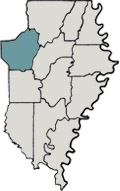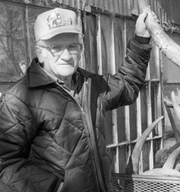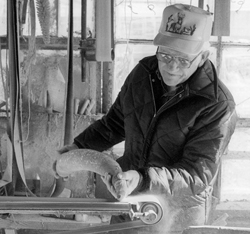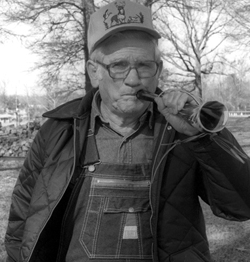Introduction to Delta Pieces: Northeast Louisiana Folklife
Map: Cultural Micro-Regions of the Delta, Northeast Louisiana

The Louisiana Delta: Land of Rivers








Ethnic Groups










Working in the Delta








Homemaking in the Delta




Worshiping in the Delta



Making Music in the Delta




Playing in the Delta







Telling Stories in the Delta



Delta Archival Materials
Bibliography

Nalda Gilmore
Ouachita Parish
Nalda Gilmore uses his blowing horns when hunting with his registered beagles. He's been making his horms for over 35 years.

Blowing Horn Maker Nalda Gilmore: "The Horn Man"
By Sylvia Frantom
Nalda Gilmore of West Monroe, Louisiana, created blowing horns for over 35 years. According to Mr. Gilmore, blowing horns, originally used to call dogs when hunting, have a very long history. He said that trumpets mentioned in the Bible refer to blowing horns made from curved sheep horn or straight she-goat horn. Nalda Gilmore's blowing horns are both functional and beautiful, and so it did not disappoint him that many people bought them for decorative purposes and fewer for hunting. He was born on January 4, 1925 in Morris County, Texas, and died on October 3, 2004 in West Monroe, Louisiana. Gilmore said he always loved making blowing horns, so his nickname was "the horn man." A blowing horn is even engraved on his grave stone.
Nalda Gilmore started making blowing horns because hunters needed them when hunting with dogs. Gilmore used his blowing horns when hunting with his registered beagles, which he used to hunt rabbits and coons. He said that he hunted almost every day during hunting season. Other times of the year, he would run his dogs twice a week.
Blowing horns are mainly used to call dogs or to signal a hunting partner. The dogs recognize each hunter's particular way of blowing a horn and will respond. Gilmore said that each person makes a different sound on the horn. He stated that blowing a horn is a lot like blowing a trumpet and that different people have distinct techniques "like whistling". A person can't be taught, and so must learn on his own to develop his own sound.
Gilmore learned to make blowing horns from V.A. Capers of West Monroe, Louisiana, a master maker, who began crafting horns at about the age of eight. The two were good friends and hunted together about two nights a week for "fifty-two weeks out of the year." Gilmore was Caper's apprentice and began by sanding horns for him "by the hour." According to Gilmore, they perfected their craft through experimenting and sharing techniques and ideas through the years.
Gilmore's techniques for creating blowing horns have changed over the years. When he first began making them, he used a broken jar or plate or any other piece of broken glass to scrape the horns. This process was very slow and it left ridges in the horns. The holes for the mouthpieces were burned with a heated piece of metal or nail. He said this smelled like hair burning. He then used a drawing knife to shave off the excess material and sand the horns by hand. This process took one or two weeks to finish a single blowing horn.
Later, Gilmore changed his materials and techniques to save time, create a more beautiful blowing horn, and to improve the tone. In the beginning, he used horns from local cattle, but later he ordered Nigerian cow horns because he said they had a better tone. Gilmore said he was glad that electric tools were invented to make his work easier and quicker. His new approach included sawing the large end off the horn with a band saw until he got the tone he wanted. The inside or pithy part slid out after a few days and deteriorated quickly. He used a steel bit to drill the hole at the top. Then, he sanded with a glass sand belt and polished with a cloth buffer. Sanding and buffing the horn brings out the natural colors of the horn, and no two horns colors or grain patterns are alike. If the horn did not have a suitable mouthpiece, he either filled it in with fiber glass and sanded it, or made a mouthpiece from another horn of a matching color to fit it.
Nalda valued the sound a horn makes equally as important as its form. He said that blowing horns sounds are either considered "coarse," low-pitched, or "fine," high-pitched. Mr. Gilmore preferred the "coarse" sound for his personal horn. He said the way "you tune it is by sawing it off" and that you "saw it off until you get the tone you want." Some of his blowing horns are made of goat horns which are triangular. He also made a horn he called a "squealer, " which is a large horn measuring about 28 inches long and used to call dogs in the rice fields of south Louisiana. This horn can be heard from a great distance. No two horns sound the same, even if they come from the same animal. Gilmore explains how the sound and physical characteristics of a blowing horn is determined by a person's personal preference:
Some people like a horn that's called a course [sounding] horn. Some people like a real fine one. We make a big, long horn that's called a squealer and they're used in the rice patties of south Louisiana. You don't blow them, you squeal them. Just tighten your lip a little bit when you blow in them and they'll squeal. And they carry a long way. They're usually from 24 to 36 inches long. [They're used] to hunt with: to call dogs. You can use these to call dogs, or you can use them to blow for your friend that's on the stand below you deer hunting to tell him you've got a kill. Or to tell him to come help you. We use them just to call our dogs, and that's mainly what they're used for. They're getting to be used for decorative purposes more than they are for use. I sell more to ladies than I do to men.
At first, Nalda Gilmore threw away waste pieces of horn, but his daughter suggested he make something out of them. He began making shoe spoons, thimbles, earrings, necklaces, key chains, bolo ties, knife handles, buttons, powder horns, and hair barrettes out of the scraps. His wife and daughter helped him make and paint many of these items. For decoration, he sometimes carved on horns with a pocket knife. His daughters scrimshawed horns and other items with a small tool similar to a dentist tool. They drew designs on the horns with the tool and filled in the scratches with ink. He began to use every part of horns-even saving the dust created when a horn is sanded for fertilizer to grow beautiful roses in his yard.
Around 1960, his wife, Vadine Dearman Gilmore, talked him into selling his blowing horns in a craft show. He told her, "Those old ladies won't like these," but he sold many horns in the show. Since then, he and his wife sold in several craft shows each year and even opened a showroom in their house. He sold his blowing horns for about $10 to $25 in 1994. He also sold his craft and demonstrated horn making in subsequent years at the Louisiana Folklife Festival in Monroe. He reflected that most women bought his blowing horns because of their decorative appeal, colors, or designs and not for the sounds they made to communicate with dogs and hunters. Many people bought his horns for the decorative appeal and not for hunting.
Nalda Gilmore explains that he liked making blowing horns for the same reason that some women say they like to sew because it's creative and relaxing:
It relaxes you. You can do a whole day at the job and you come home frustrated, as you might know, and then you do something you like to do, like digging in the garden. Well, I make horns, and it relaxes me. When I don't want to make a horn, I can't make a good horn, just like a lady sewing. I'll mess up as much as I make. It is a hobby. It's just something you like to do. It's just like some people like to fish, I like to run my dogs about two nights a week. We just do it for relaxation. Oh, I made these things (his blowing horns) 35 years and my wife told me one day, why don't we carry them to a craft show. And I said, those old women ain't gonna buy nothing. Then I sold more at one craft show than I usually sold in a year. So, we've been going to craft shows ever since. We do about 12 or 13 a year. [I have taught] several people but they don't want to follow it up. It's a dusty little trade. I have to hang my clothes in the back porch when I come from the horn shop sanding because the odor accumulates in the clothing. A lot of people just don't like the dust or the smell of the horns. I've showed a lot of people how to do it. But very few follow. I have two daughters who make horns. They do scrimshaw and western art painting.
He taught a number of people to make blowing horns, but few continue with the tradition. Some people don't like it because it is a "dusty trade" due to the sanding process. His two daughters know how to make the blowing horns and other objects made from horn; however, he said he didn't know if anyone would ever continue his craft. It is encouraging to note that since Gilmore's death, one of his daughters, Nelda Gilmore Rowlan is continuing to make blowing horns in hopes of carrying on her father's tradition. Nalda Gilmore created blowing horns for over 35 years both to use for hunting with dogs and as artistic pieces. Gilmore liked the fact that even if a horn looks unremarkable in the rough, it can become an object of beauty when polished. Perhaps his greatest satisfaction came from making objects that others enjoy.






